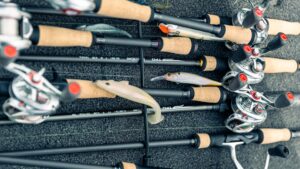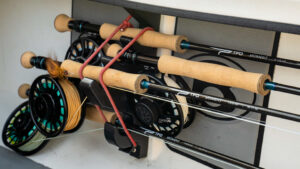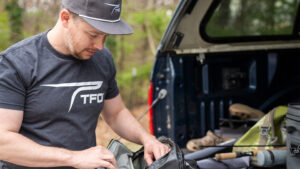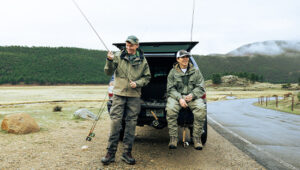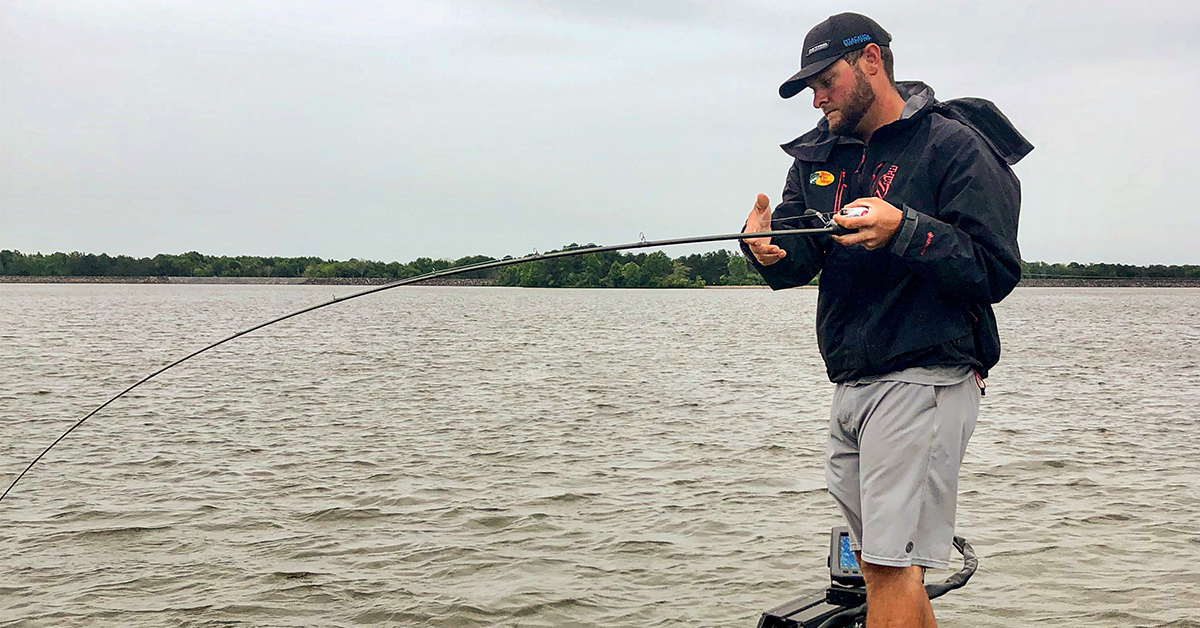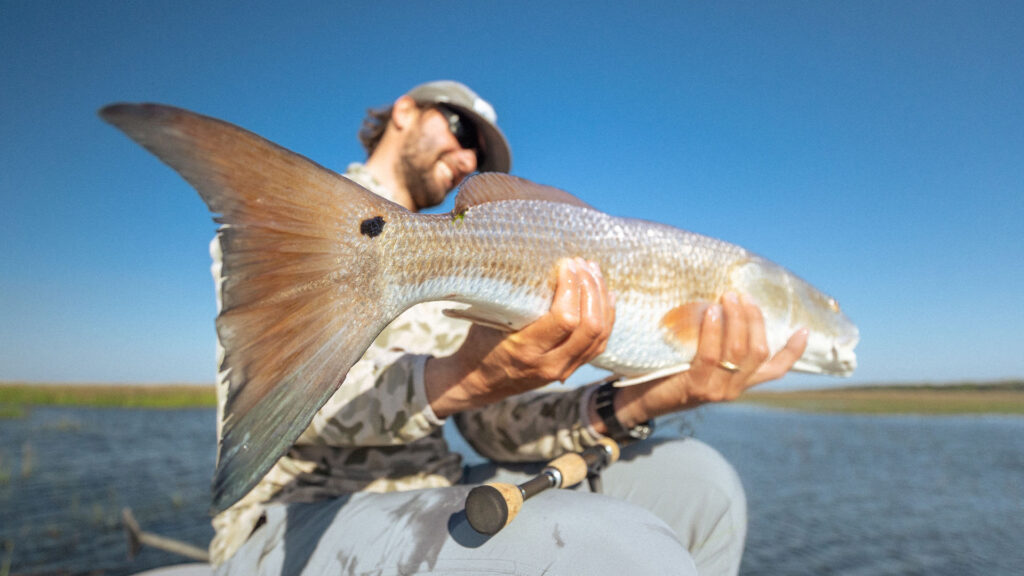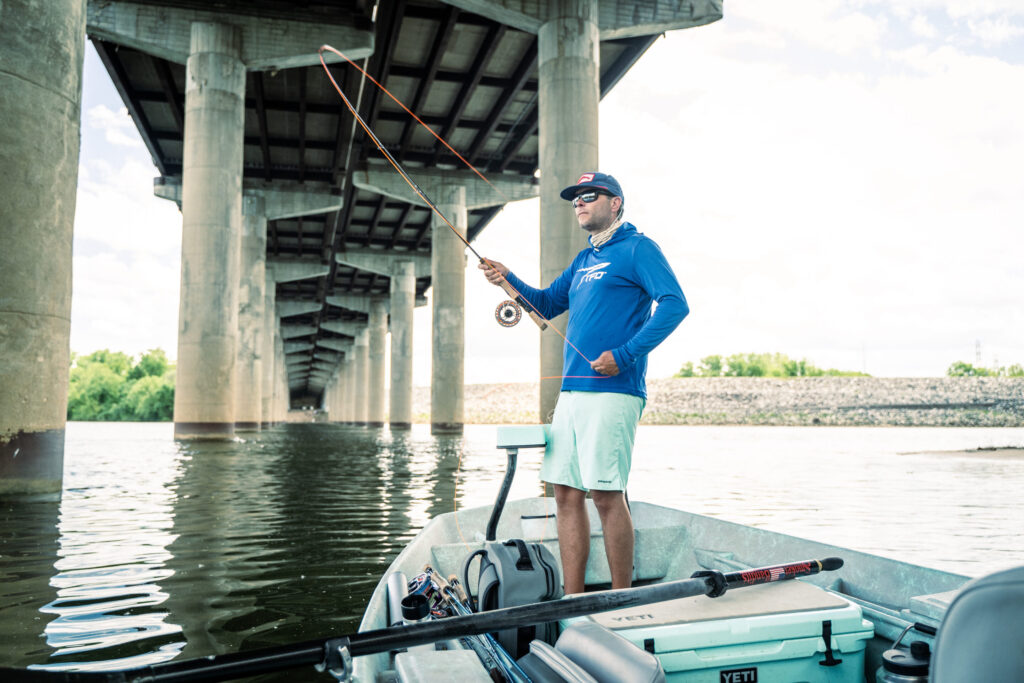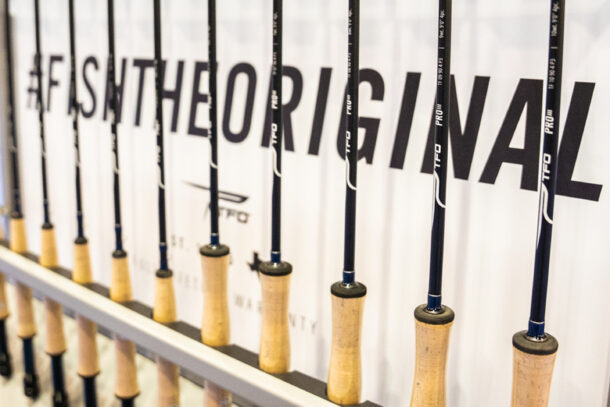August can be a challenging time of year for bass anglers, but very rewarding for those that know where and how to look for fish. Being willing to be versatile and switch up your tactics is crucial, and TFO Ambassador Joey Nania does exactly that when fishing the Coosa River system in Alabama. If you aren’t familiar with Joey or the Coosa River system, just take a look at his Instagram (@joeyfishing), and you’ll get a glimpse of the very healthy bass that come out of these lakes and rivers. If there’s anyone that knows how to find these fish, it’s Joey Nania.
We got on a call with Joey in between his family time and guided trips to catch up, and to talk about how he’s finding (and catching) bass during the hottest and most difficult times of year – the dog days of summer.
To start things off, let’s talk about the fisheries/areas where you are fishing and what brings you to this area.
I’m from Washington state originally, but my family and I now live in the hot, but very beautiful state of Alabama. I specifically chose Birmingham (Pell City, AL) for the many amazing fisheries in the surrounding areas. I mainly fish the Coosa River system, which entails Weiss Lake, Lake Neely Henry, Lake Logan Martin, Lay Lake, Lake Mitchell and Lake Jordan. There’s a ton of diversity and fishing options within this river system, and for a guy that fishes tournaments and guides around 200 trips a year, this area is paradise.
Sounds perfect for you. What do conditions typically look like on the Coosa River this time of year? How do you decide where and when to get out on the water as opposed to other times of year to maximize your fishing time?
We get the four seasons like everyone else, but we get some long, hot summers! It’s not uncommon to have days in the 90s for 3 months consecutively, with water temps in the high 80s to low 90s. When there’s not much current and things are tough like they are right now – the fish are all over the place. When there’s a lot of flow, fish set up on specific places on the main river and places that current flushes over, and they really group up in big groups. When the oxygen gets low and there’s not much current flowing, the fish start to disperse. That tends to happen on one end of the lake to the other.
Typically, I like to narrow down locating the fish by breaking down/targeting different sections of the lake –which I’ll break down in two sections:
1) The Upper End – Where you’ve got your narrow, winding rivers with lots of lay downs and trees/logjams and then you’ve got rock piles. Those are the three structure options up in the rivers that I like to focus on.
2) The Bottom End – As you come down toward the bottom end of the Coosa River lakes, they widen out and you’ve got big major creeks flowing in. Every lake on the Coosa River has several big feeder creeks that are good contributors of fresh water that are also great backwaters for the fish to go to when they are spawning. The bottom end has a lot more open areas for the fish to roam, feed and hide.
I typically like to focus more of my time fishing the upper ends of the rivers this time of year. It’s narrower up there so when they do run the water (generators), at least there’s flow that you can feel. When they’re only running one generator on the bottom ends of our lakes, you really can’t feel a whole lot of current. Water is typically warmer there, thus more lethargic fish.

Let’s talk about fishing the bottom ends of the lakes first. Where are you looking for fish and how are you targeting them (baits/setups)?
On the bottom end, if I’m going to fish the main parts of these lakes and the bigger creeks, what I target a lot of the times is docks, grassy areas, and then you’ve got your offshore fish. When fish leave those deep schools where they group up by the hundred, a lot of them to go to brush piles. There’s always fish in man-made brush piles on these lakes in the south. I’d probably say the brush pile bite is the best, but in the dog days of the summer, no matter where you are, offshore fishing is always an option. There’s plenty of fish that spend most of their life offshore.
From Frogs To Flipping Baits – Working The Banks
The key to being successful during the dog days of summer is being versatile – especially on the lower ends of lakes. Typically I like to start shallow, and fish that way as long as possible. You’ve usually got shade and willow grass and other types of grass, which produces oxygen and provides excellent places for bass to find a meal. A lot of the times I start off with a frog pattern or swim a jig, but it seems like for me, as it gets hotter the swim jig bite typically fades away. You can still get some on the frog, but I really love flipping. Just slowing it down a little bit and you can be very efficient and cover a lot of water and hit the little shade pockets and really get the bait in front of the fish when you slow it down and pitch it down down the bank. It’s not really flipping, it’s pitching – Taking that underhand cast and skipping it under the overhanding cover; it’s just a very effective way of fishing this time of year.
For this scenario, I really like fishing the 7’3” Heavy Tactical Elite Bass (TLE MBR 736-1). I love that 7’3” Heavy! To me, that’s the most versatile heavy line rod that TFO makes. I throw this rod a ton. The 7’3” is the most effective rod for skipping, pitching, fishing tight covers, flipping jigs – Pretty much every bait I fish with anywhere from 17lb lines to 50lb braid, I rely on that 7’3” Heavy. It has such a perfect backbone for setting the hook. You can crack it and feel there’s no give when you set the hook really. But the tip is nicely tapered. It’s almost like a hybrid medium heavy rod in my opinion, but that’s what’s neat in that there’s no industry standard to come up with each power and it be the same for every company. This rod and other TFO rods are so perfectly balanced, and they’re true to what they’re supposed to be – an easy and reliable rod to fish with.
I like to throw the 7’5” Heavy Tactical Elite Bass (TLE FS 756-1) for fishing with frogs on mats. With this style/setup I’m typically making longer casts and forcing them out. I like to have that longer rod/leverage to get them out of the mats.

In terms of patterns, my go-to is the pop-n-frog. The new Z-Man Leap FrogZ Popping Frog. Bluegills make a really specific noise when they slurp a bug off the surface. They’ve got a really perfect cupped mouth. I feel like 90% of the time when they are eating your frog in open water or up under stuff, they really probably think it’s a bluegill. It’s just something up there that looks good to them. They’re predators and just looking for a good meal, and when something’s pretty big and twitching above them, they’re probably going to eat it. When a bass is sitting up under a tree or in the grass in the summertime – they’re comfortable. They’re sitting, they aren’t moving. Just in a holding place waiting to strike when food presents itself. Its almost like when you’re sitting in your chair at home and your wife comes home with a pizza – you’re probably going to go after that pizza (laughs).
For my jigging set-up, if the water is really clear, typically I’m using 20lb fluorocarbon on a high-speed reel. I use an 8:3:1 reel so I can be very quick and efficient. Usually when I’m working the banks, I don’t keep the bait out of the water for very long – just in and out. Working that jig, just trying to fish every single piece of cover that could hold fish.
What about retrieval patterns for fishing top water stuff?
I really think one of the keys to fishing frog patterns is the fact that the bait can walk. You can make the bait walk the dog where it’s jumping from side to side. That walk the dog action where you’re twitching and popping 5 to 6 inches from to left to right each time you twitch it – it makes the bait stay in the strike zone longer. On really hot days, it might not hurt to fish it a little slower, but there might be days where you’ve got to make them react, and slower retrieves might not trigger that response. I just vary it up depending on the day. Find what works and stick to it. Changing your retrieves, changing your tactics, and just knowing that each day is different is key to finding more success on the water during the dog days of summer.

Let’s say the sun is coming up and the morning bite is slowing down on the banks. Now you’re deciding to focus on the offshore bite. How are you looking for fish offshore and what are you throwing?
My very favorite way of catching bass is on deep schools. Part of that is being a guide and its just so much fun to put people on fish and that usually works the best for my clients. There’s certain summers where there’s definitely schools of fish to be found offshore. Our school fish here disappeared in the last month, but that doesn’t mean they always do that or they’re going to do that everywhere. So really, for the deep schools – what I’m going to start doing if the dams are running current, I’m going to start idling, and looking out offshore for schools of bass. Learning how to use your electronics is definitely important in the dog days of summer. As soon as you leave that bank, its super important to know where to look for fish and how to get the bait in front of them.
Brush Piles & Finesse Jigs
If there isn’t any generation current and I can’t find any schools of fish because its so hot, I’ll go and start fishing brush piles. It doesn’t have to be deep brush piles. Some of the best brush I fish is in 8 to 12 feet of water. One of my very favorite brush baits to throw is a CrosseyeZ Power Finesse Jig with a TRD BugZ trailer in the back. For this setup, I’m fishing the same rod – 7’3” Heavy Tactical Elite Bass with an 8:3:1 reel. I’ll use 17-20 pound test fluorocarbon cause I’m fishing it out off the bank and I like to have it fall through the water a little better with a lighter line. This is a prefect combo for a finesse jig. Sometimes the fish want something with a little bit more finesse, so if that’s the case, I’m switching over to a spinning rod.

Spinning Rods & Ned Rigs
A spinning rod is definitely something you’ve got to have ready during the dog days of summer. To me, a ned rig is one of the best rigs you can throw out there and also a dropshot. My favorite ned rig set up is a 1/6 oz. Ned LockZ Jighead. That 1/6 oz. is the right weight for fishing that depth, but if I’m fishing docks and stuff where its more shallow, I’ll do 1/10 oz., but that 1/6 oz. is great for getting down quicker. The bait I use is a Finesse TRD. I actually rig mine weedless. I fish it like a miniature shakey head on a Jighead just much smaller. That way I can throw it into brush and when the bait swims with that shakey head style rig, it makes it swim at a 45 degree angle rather than standing straight up off the bottom, and I just feel like I get less drag and it looks really good, too.
The spinning rod that I use for this set up is the 6’10” Medium Tactical Elite Bass (TLE SHS 6104-1). I use 10lb braid to an 8 or 10lb test fluorocarbon leader. In October, TFO is coming out with a 7’1” Medium Light that is an amazing ned rig rod that has a perfect back bone for that style of fishing with a great tip as well. Highly recommend that rod when it does come out!

Photo: Cameron Mosier/Tribal Video
Let’s switch things up and head up river. Talk about how you are fishing these sections this time year.
I typically spend more time on the river sections in the summer as there is more shade/cover, typically more current/flow from the generation, and the area for the fish to be in is a lot narrower compared to the bottom end of the lakes so it can be easier to find them. What I’ve been catching them on lately is my favorite way to catch them – which is flipping my finesse jig toward the banks. There’s also a pretty good squarebill bite a lot of the time during the dog days. Ive got a 6th Sense Crush 100x Squarebill I throw that will get down to about 6 – 8 feet where I can fish logs and other structures off the bank.
The rod I’ve been using for this setup is the 7’4” Medium Heavy Tactical Glass Bass rod that is coming out in October. That rod has that unique 60/40 bend where its 60% carbon fiber/40% fiberglass. Great rod for throwing crank baits, really perfect for throwing squarebills, but also an incredible chatterbait rod. Fishing those outer trees off the bank with a medium crankbait on all the rivers throughout the South is a good way to make fish react.

Photo: Cameron Mosier/Tribal Video
If the tree bite dies, I usually look for rock piles offshore that create any visual disturbance in current flow on the river. Basically any type of structure/rock pile that holds perpendicular to the current where the current rolls over it, there’s usually a great spot for bass to hold up in, and I have a lot of success targeting those areas. I really enjoy fishing a 6th Sense Cloud 9 C10 Crankbait on offshore rock piles in 6 to 12 feet of water. I typically stick with shad colors, but if the waters a little dirtier, I’ll go with a chartreuse.
I like to do long casts in this scenario because I want my bait to track on the bottom for a longer period of time and hit all those rocks/lips where the drops are. For this situation I’m throwing what I think is by far the best cranking rod for this scenario, and it’s the 7’10” Medium Heavy Tactical Glass. This rod is the perfect flexing catapult that launches crankbaits and for making those longer casts.

A Forgotten Tip…
We’ve talked about the offshore fishing on the bottom end, and hitting up the upper main river sections where’s there’s more grass/laydowns/structure and it’s a little cooler, but one forgotten tactic that not a lot of people think about is fishing the very back ends of creeks this time of year. It seems totally weird to go about 5 miles off the main channel to the very back of a shallow creek when its that hot out. Anytime we get any rain, the water is going to flush into those creeks, so when I’m going down the river, I like to target the back ends of those feeder creeks where the water is a little cooler. If you really do your homework and target specifically spring creeks, you can find bass that are pretty much residential in that everything they need is provided by the resources in those creeks and they really don’t need to migrate to the lakes. You can find some really nice bass in these creeks.
A great tactic for this scenario is skipping a buzz bait up under bushes. I like to use a 7’4” Medium Heavy Tactical Elite Bass. Flipping a finesse jig is also very practical as well. I usually stick with similar patterns as I would on the main river. Again, that’s with the trusty 7’3” Heavy Tactical Elite Bass.

Photo: Cameron Mosier/Tribal Video
For the angler working on a budget, or to simplify a boat setup – If you could only take 3 rods/baits for this time of year, what would you take and why?
1) The finesse jig would be my first pick. Jigs are such an old school way of fishing, but they really are one of the most versatile baits there are. Especially if you get one that’s weighted properly – you can fish one from 2 feet deep to 20 feet deep, and really feel it down there and make it move the way you want to.
2) No matter what time of year, I like having a chatterbait rigged up. You can fish them shallow and slow roll it a little bit deeper. Chatterbaits just get bit. Especially the Chatterbait Jackhammer that hunts and cuts. I like to fish a Zman Diesel MinnowZ swimbait trailer off my Chatterbait Jackhammer. The ultimate setup for this scenario is with a 7’4” Medium Heavy Tactical Glass Bass rod. I fish it with a 6:8:1 reel and 17lb fluorocarbon.
3) I really believe that having a spinning rod and having a ned rig is important. No matter what time of time, having a neg rig ready is such a good idea. This is probably my most trustworthy/reliable setup for clients anytime of year. For this set up, I’ve using the 6’10” Medium Spinning Tactical Elite Bass, but I’m really excited for the upcoming 7’1” Medium Light Spinning Tactical Elite Bass that’s coming out this fall.

Based out of Pell City, Alabama, Joey Nania has been a TFO Ambassador since 2012. He is also an ambassador for Z-Man baits, Bass Pro Shop, and many other brands. Prior to coming onboard to TFO, he began fishing tournaments since he was 12 years old. He worked his way to fishing in high school and Junior Bass tournaments, and is now fishing professional tournaments regularly. Joey runs a guiding service, Joey Fishing, where he is on the water with clients about 200 days a year. Outside of guiding, you can find Joey on the water with his family, as his wife and two sons, Zeke and Eli love to fish as well. You can follow or get a hold of Joey on his Facebook or Instagram pages or at his website.
![]()
